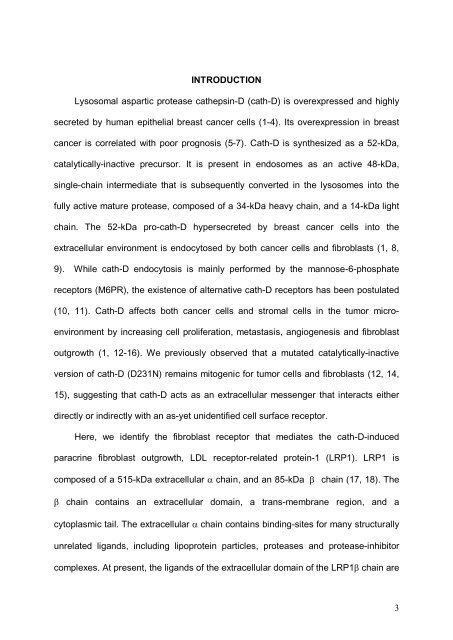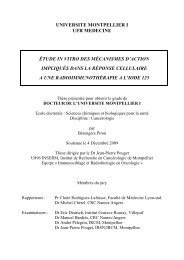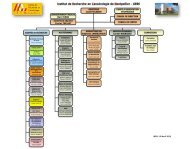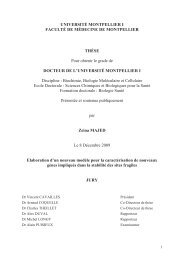Cancer du sein et micro-environnement tumoral: rôle de la protéase ...
Cancer du sein et micro-environnement tumoral: rôle de la protéase ...
Cancer du sein et micro-environnement tumoral: rôle de la protéase ...
You also want an ePaper? Increase the reach of your titles
YUMPU automatically turns print PDFs into web optimized ePapers that Google loves.
INTRODUCTIONLysosomal aspartic protease cathepsin-D (cath-D) is overexpressed and highlysecr<strong>et</strong>ed by human epithelial breast cancer cells (1-4). Its overexpression in breastcancer is corre<strong>la</strong>ted with poor prognosis (5-7). Cath-D is synthesized as a 52-kDa,catalytically-inactive precursor. It is present in endosomes as an active 48-kDa,single-chain intermediate that is subsequently converted in the lysosomes into thefully active mature protease, composed of a 34-kDa heavy chain, and a 14-kDa lightchain. The 52-kDa pro-cath-D hypersecr<strong>et</strong>ed by breast cancer cells into theextracellu<strong>la</strong>r environment is endocytosed by both cancer cells and fibrob<strong>la</strong>sts (1, 8,9). While cath-D endocytosis is mainly performed by the mannose-6-phosphatereceptors (M6PR), the existence of alternative cath-D receptors has been postu<strong>la</strong>ted(10, 11). Cath-D affects both cancer cells and stromal cells in the tumor <strong>micro</strong>environmentby increasing cell proliferation, m<strong>et</strong>astasis, angiogenesis and fibrob<strong>la</strong>stoutgrowth (1, 12-16). We previously observed that a mutated catalytically-inactiveversion of cath-D (D231N) remains mitogenic for tumor cells and fibrob<strong>la</strong>sts (12, 14,15), suggesting that cath-D acts as an extracellu<strong>la</strong>r messenger that interacts eitherdirectly or indirectly with an as-y<strong>et</strong> uni<strong>de</strong>ntified cell surface receptor.Here, we i<strong>de</strong>ntify the fibrob<strong>la</strong>st receptor that mediates the cath-D-in<strong>du</strong>cedparacrine fibrob<strong>la</strong>st outgrowth, LDL receptor-re<strong>la</strong>ted protein-1 (LRP1). LRP1 iscomposed of a 515-kDa extracellu<strong>la</strong>r a chain, and an 85-kDa b chain (17, 18). Theb chain contains an extracellu<strong>la</strong>r domain, a trans-membrane region, and acytop<strong>la</strong>smic tail. The extracellu<strong>la</strong>r a chain contains binding-sites for many structurallyunre<strong>la</strong>ted ligands, including lipoprotein particles, proteases and protease-inhibitorcomplexes. At present, the ligands of the extracellu<strong>la</strong>r domain of the LRP1b chain are3





